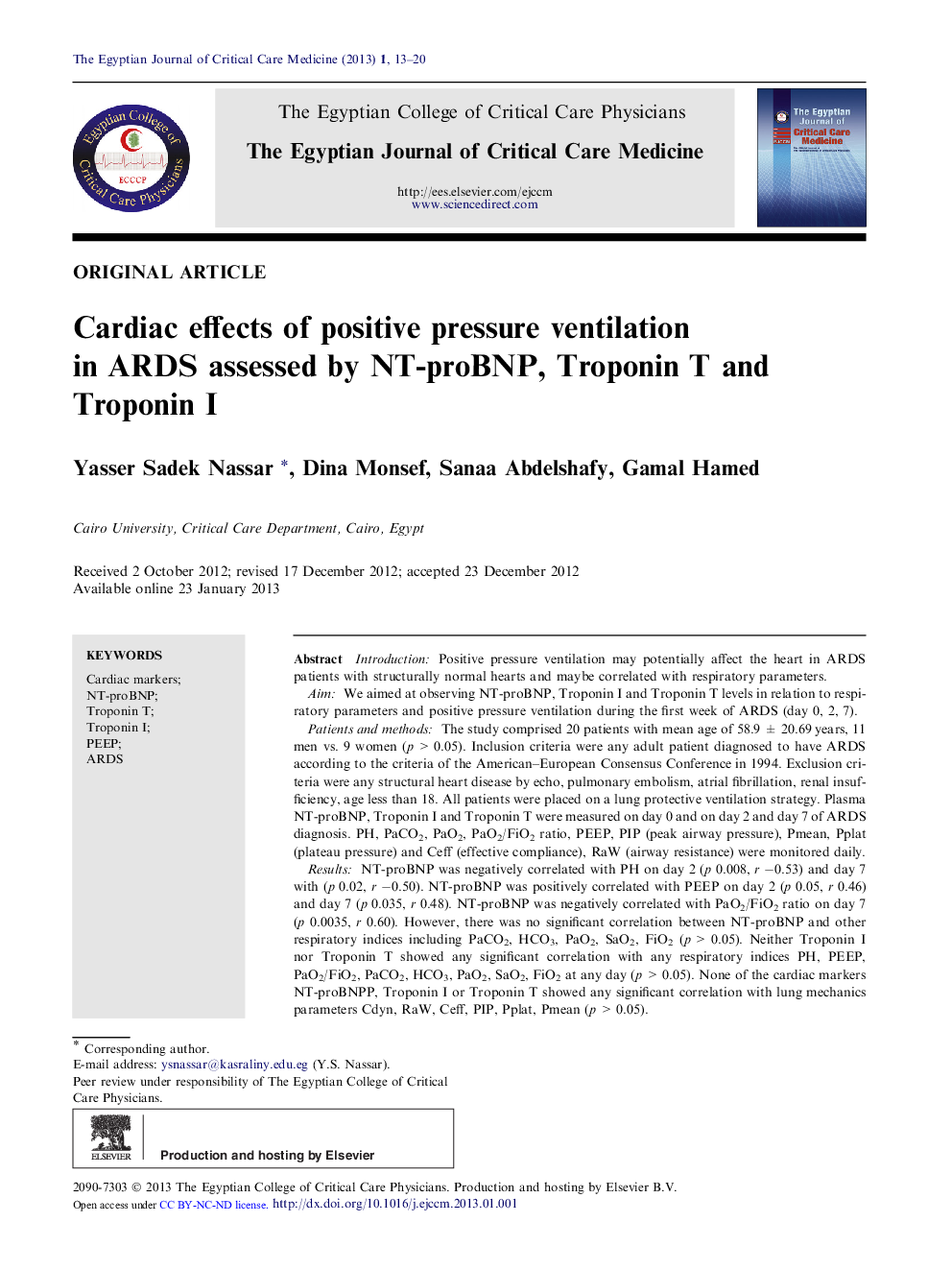| Article ID | Journal | Published Year | Pages | File Type |
|---|---|---|---|---|
| 2910925 | The Egyptian Journal of Critical Care Medicine | 2013 | 8 Pages |
IntroductionPositive pressure ventilation may potentially affect the heart in ARDS patients with structurally normal hearts and maybe correlated with respiratory parameters.AimWe aimed at observing NT-proBNP, Troponin I and Troponin T levels in relation to respiratory parameters and positive pressure ventilation during the first week of ARDS (day 0, 2, 7).Patients and methodsThe study comprised 20 patients with mean age of 58.9 ± 20.69 years, 11 men vs. 9 women (p > 0.05). Inclusion criteria were any adult patient diagnosed to have ARDS according to the criteria of the American–European Consensus Conference in 1994. Exclusion criteria were any structural heart disease by echo, pulmonary embolism, atrial fibrillation, renal insufficiency, age less than 18. All patients were placed on a lung protective ventilation strategy. Plasma NT-proBNP, Troponin I and Troponin T were measured on day 0 and on day 2 and day 7 of ARDS diagnosis. PH, PaCO2, PaO2, PaO2/FiO2 ratio, PEEP, PIP (peak airway pressure), Pmean, Pplat (plateau pressure) and Ceff (effective compliance), RaW (airway resistance) were monitored daily.ResultsNT-proBNP was negatively correlated with PH on day 2 (p 0.008, r −0.53) and day 7 with (p 0.02, r −0.50). NT-proBNP was positively correlated with PEEP on day 2 (p 0.05, r 0.46) and day 7 (p 0.035, r 0.48). NT-proBNP was negatively correlated with PaO2/FiO2 ratio on day 7 (p 0.0035, r 0.60). However, there was no significant correlation between NT-proBNP and other respiratory indices including PaCO2, HCO3, PaO2, SaO2, FiO2 (p > 0.05). Neither Troponin I nor Troponin T showed any significant correlation with any respiratory indices PH, PEEP, PaO2/FiO2, PaCO2, HCO3, PaO2, SaO2, FiO2 at any day (p > 0.05). None of the cardiac markers NT-proBNPP, Troponin I or Troponin T showed any significant correlation with lung mechanics parameters Cdyn, RaW, Ceff, PIP, Pplat, Pmean (p > 0.05).ConclusionsIn patients with ARDS positive pressure ventilation may adversely affect the heart as reflected by elevations of NT-proBNP. High NT-proBNP level was correlated with high PEEP, low PH and low PaO2/FiO2 ratio while Trop T and Trop I did not show significant correlations with respiratory parameters. None of the cardiac markers NT-proBNP, Troponin I or Troponin T showed any significant correlation with lung mechanics parameters (Cdyn, RaW, Ceff, PIP, Pplat, Pmean, p > 0.05) in ARDS patients with structurally normal hearts.Although the increase in cardiac markers are insignificant, yet they point to the potentially harmful role played by high PEEP, low PH and low PaO2/FiO2 ratio on the heart. Currently, no clinically relevant conclusion can be drawn apart from the recommendation to attempt to lower PEEP and shorten the duration of positive pressure ventilation, even in patients with structurally normal hearts.
